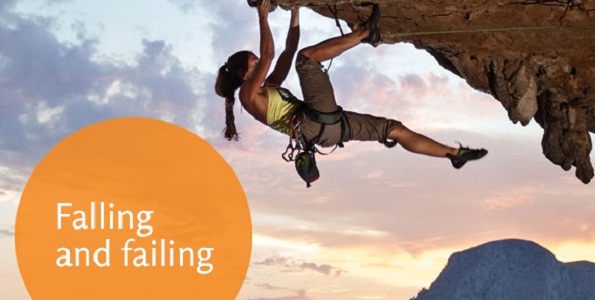Falling and falling
Happy New Year, everyone! I hope 2016 brings you and those you love all you wish for.
And while we’re on the subject: what exactly did you wish for this year? In fact, how are those new year’s resolutions going? And what about last year’s resolutions – did you follow through?
I ask because I want to talk about resolutions in general. Particularly those that don’t work out.
In my case, some of last year’s resolutions went well (like this newsletter, the result of a 2015 resolution) and some didn’t. For example, I resolved to sail the Sydney to Hobart with my father. And I did, even though I was scared, both before and during. Let me tell you, being in a small yacht in an 8-foot sea swell is pretty terrifying stuff.
But our brave yacht Pazazz didn’t finish. We were forced out of the race at Ulladulla because the wind ripped our mainsail to shreds and because my father’s back injury flared up, making him unable to sail on. (He had surgery last week and is now on the road to recovery).
I was trying to make sense of this when I came across an article in the New Yorker, titled The Wall Dancer. it’s about a 14 year old girl called Ashima Shiraishi. Ashima’s considered the greatest rock climber ever, a prodigy who regularly beats adult climbers and conquers the most difficult possible climbs. She is to rock climbing what Anatoly Karpov is to chess (OK, OK, I googled ‘chess champions’. But I wanted to make the point because climbing is partly about solving logistical puzzles).
The article contains a short clip of Ashima talking about why she climbs. She says
99% of the time it’s frustration and falling…it hurts a lot and it’s hard to get over falling and failing. The reason I climb is because of the satisfaction you feel after getting to the top. You realise that all the frustration and stress you put into it was worth it.
Ashima puts into words exactly what I feel about climbing, too. And about sailing and about business and everything else I do. I want to reach that summit, cross that finish line, produce and sell my very best services. And sometimes things don’t work out along the way.
It’s hard to get over ‘failing and falling’. The idea of failure can be so scary we don’t even want to start a venture, or we abort something we started for fear of trouble ahead. But unless we take risks, unless we reach out for what we want, we’ve got no chance of winning at all.
When you think about it, aren’t resolutions – and undertakings in general – first and foremost about risk? Sometimes those risks work out and sometimes they don’t, or not the way you thought they would. The point is to have a go, mostly because we hope to succeed but also because of what we learn, even from our most abject failures.
Take my company, Springday. For us, 2015 was a very successful year. We’re expanding and getting stronger – going great guns. Yet, since I’m being honest, last year there were also a couple of ventures that didn’t go so well, directions we’ve pulled back from. Those exercises weren’t a waste of time because they made us look carefully at, and refine, the essence of what we do at Springday, namely helping people and companies practice wellbeing. In fact, we came up with a short clip describing what we actually do. If I say so myself, it rocks!
Our reflection also helped us think outside the box. As a result, we’re taking on board some very exciting new developments. For example, we’re widening our client base to include fitness companies, with Willows Health and Lifestyle the first cab off the rank in this area.
We’re also expanding our wellbeing bank, what we call our Springday app store to include a range of talks and events, so we can produce experts and their learning at the touch of a button. Which means companies won’t have to book and pay for them to appear in person. And finally, we’ve refreshed and re-energised our activity, nutrition and sleep challenges.
All these changes came out of what didn’t – as well as what did – work. And they helped me set my resolution this year. Like Ashima, I’m going to take risks, face my fears and reach for my own summits. So 2016 looks pretty exciting to me, and I hope to you as well.
What’s going on
Talking about new year’s resolutions, here’s a guide to nailing them: from Greatist, the most popular new year’s resolutions and how to make them stick.
The top six good news stories of 2015: our daily news is dominated by disaster, from terrorism to animal cruelty. To counter this, Bill Gates lists some good things that are happening on planet earth.
Happiness doesn’t help you live longer: every self-help book says happiness can change your life and maybe that’s true, but being happy won’t make you live longer. A study of hundreds of thousands of women finds no difference between the lifespans of the happy and the grumpy.
Gamifying health: with almost all of us playing games – on our phones, our PCs and even our iPads (remember them?) it comes as no surprise to learn that games are being developed to support better health, including learning, reflexes, and peace of mind. This short article describes just a few.
The number one new year’s resolution every leader should make: short but very important, especially if you want to do more than ‘talk the talk’. Read this, and especially the questions leaders should ask themselves.
Hottest jobs in 2016: if you’re thinking of changing jobs this year, here are the areas most in demand.
Why millennials don’t want to work for you: Gens Y and Z are an increasing part of the workforce and they’re a law unto themselves. If they don’t want to work for you – or stay with you – you’re in trouble. Here’s what you can do to get, and keep, the best talent in the millennial pool.
What we can learn from elite athletes’ winning strategy: this article describes the process used by a top American football team to help them win championships. We can use it too, to order our minds, stop us panicking, and help us navigate the complex challenges life throws at us.
Read this Google email about time management strategy: it’s one of Fastcompany’s top 10 leadership stories of 2015. It’ll improve your productivity.
12 minutes of yoga for bone health: yoga is good medicine. It improves flexibility, range of motion, muscle strength, posture and balance. And it increases self-awareness and self-esteem. Now, research shows that certain yoga postures, done for 12 minutes every day or every other day, can serve as a therapy for osteoporosis. Namaste!
SpaceX’s thrilling achievement: commercial space travel is becoming a reality. SpaceX, a company which manufactures spacecraft, recently launched a rocket which sent satellites into space before coming back to land on a small pad in Florida. Here’s the clip, which illustrates just how huge a technical achievement this is.
Tech tips
I was at an outdoor dinner this Christmas, on a warm summer night. We were looking up at a star-studded sky. Then someone pulled out their phone, pointed it at the heavens, and started naming the stars and constellations above us.
Turns out he was using a wonderful app called Sky Map, available on Google for Android. You point your device at the sky and Sky Map tells you exactly what you’re looking at.
Perhaps it was the champagne, but Sky Map made me feel as if I was travelling in a strange and exotic land. Try it yourself and see.
And another thing
Amazing science behind what music does to our brains: can our choice of music predict our personality? How does happy or sad music affect what we see? What kind of music improves creativity? Find out in this fascinating article.
Are you a lark or an owl? This article lists outcomes of some scientific studies of morning versus night people, to show that while morning types may be happier, night owls are drunker, smarter, and get more action.
Gym wildlife: this hilarious video could have been made by David Attenborough himself. Watch and weep.










